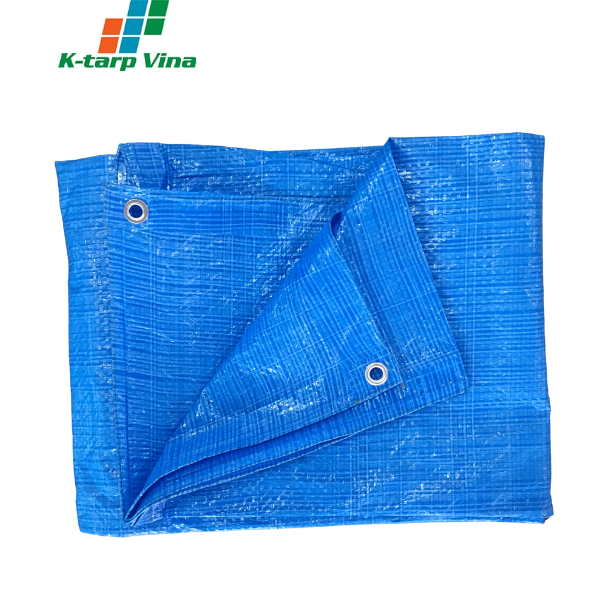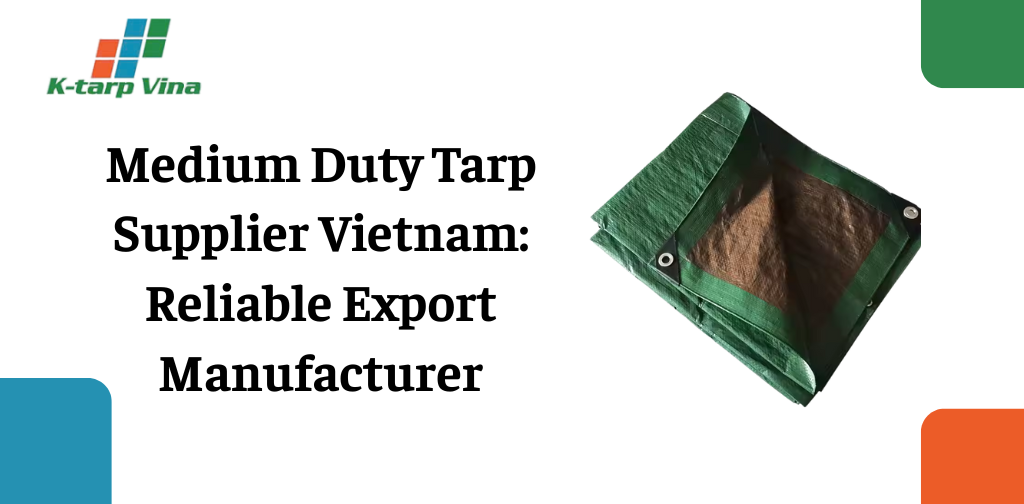A waterproof tarpaulin is a synthetic material made from plastics such as PVC, PE, or HDPE, designed to provide 100% waterproofing, UV resistance, tear resistance, and durability against harsh weather conditions. With its affordability and versatility, the waterproof tarpaulin is widely favored in agriculture (covering ponds, protecting crops, and shielding produce), construction (covering structures, lining foundations, and reservoirs), and daily life (tents, vehicle covers, and awnings). In this article, join Ktarp as we explore what a waterproof tarpaulin is, its practical applications, and the outstanding benefits you can’t overlook!
What is a Waterproof Tarpaulin?

A waterproof tarpaulin is a specialized material primarily made from Polyethylene (PE) or High-Density Polyethylene (HDPE), renowned for its ability to completely prevent water penetration. Utilizing advanced manufacturing techniques such as extrusion or film lamination, waterproof tarpaulins offer high durability, lightweight design, and exceptional resistance to extreme weather conditions like heavy rain, intense sunlight, or high humidity. This product is not only robust but also easy to customize, making it suitable for a wide range of applications, from residential to industrial uses.
Key Features of Waterproof Tarpaulins:
-
Absolute Waterproofing: With a sealed plastic film structure, the tarpaulin completely blocks water infiltration, ensuring optimal protection for goods, construction materials, agricultural produce, or structures from rain and moisture.
-
UV Resistance: A UV-resistant coating allows the tarpaulin to maintain its color and structural integrity even under prolonged exposure to sunlight, extending its lifespan for years.
-
Lightweight and Flexible: Waterproof tarpaulins are lightweight, easy to transport, install, fold, or roll up, requiring minimal storage space. This flexibility makes them ideal for both temporary and long-term applications.
Learn more: Alibaba Ktarp Vina
Applications of Waterproof Tarpaulins

Thanks to their absolute waterproofing, UV resistance, and high durability, waterproof tarpaulins are widely used for their versatility, flexibility, and effectiveness. From construction and agriculture to aquaculture, industry, transportation, daily life, and even advertising, waterproof tarpaulins meet diverse protection and optimization needs across various scenarios. Below are the primary applications of waterproof tarpaulins, detailed by sector:
1. Construction
In the construction industry, waterproof tarpaulins play a vital role in protecting structures and optimizing work environments:
-
Covering Materials and Machinery: Tarpaulins are used to shield cement, sand, steel, machinery, and equipment at construction sites from rain, dust, or harsh sunlight, preserving material quality and extending equipment lifespan.
-
Temporary Worker Shelters: Waterproof tarpaulins are employed to create temporary tents or shelters at construction sites, providing dry and comfortable workspaces to ensure project progress in adverse weather.
-
Waterproof Lining for Structures: Tarpaulins serve as liners for foundations, reservoirs, or roofs, preventing water seepage into structures, enhancing durability, and protecting buildings from moisture-related damage.
2. Agriculture

Waterproof tarpaulins are indispensable in agriculture, supporting crop protection and production optimization:
-
Covering Greenhouses and Nurseries: Tarpaulins are used as roofing for greenhouses or planting areas, shielding crops from heavy rain, frost, or extreme heat while maintaining a stable environment for growth.
-
Lining Irrigation Ponds: Waterproof tarpaulins line the base and sides of ponds or reservoirs for irrigation, preventing water leakage and ensuring a consistent water supply for crops.
-
Mulching Film: Tarpaulins are spread over soil to retain moisture, prevent weed growth, and protect against erosion, boosting crop yields.
3. Aquaculture
In aquaculture, waterproof tarpaulins enhance farming efficiency and environmental protection:
-
Lining Ponds for Shrimp and Fish Farming: Tarpaulins line the base and sides of aquaculture ponds, creating a clean environment, preventing soil contaminants and bacteria from entering, and maintaining stable water quality for healthy shrimp and fish growth.
-
Preventing Water Leakage: With absolute waterproofing, tarpaulins retain water in ponds, minimizing loss, reducing pumping costs, and maintaining optimal water levels for farming.
-
Easy Cleaning and Maintenance: The smooth, non-absorbent surface of tarpaulins simplifies pond cleaning, reducing waste buildup and pollution risks.
4. Industry and Transportation

Waterproof tarpaulins are ideal for protecting goods and equipment in industrial and transportation activities:
-
Covering Goods and Equipment in Warehouses: Tarpaulins shield machinery, raw materials, or products in storage from moisture, dust, and damage, ensuring quality before distribution.
-
Protecting Goods During Transport: During transportation, waterproof tarpaulins cover goods on trucks, containers, or ships, safeguarding them from rain, sun, dust, and adverse weather, especially for perishable items like food or electronics.
-
Production Applications: Tarpaulins are used as liners or shields in factories and workshops to protect production lines and products in humid environments.
Benefits of Using Waterproof Tarpaulins

Waterproof tarpaulins are highly versatile, offering numerous benefits in protecting assets, reducing costs, and meeting diverse needs across construction, agriculture, industry, and daily life. With their absolute waterproofing, durability, and flexibility, they are not only cost-effective but also enhance work efficiency and contribute to environmental sustainability.
1. High Durability and Superior Resilience
Made from Polyethylene (PE), HDPE, or PVC, waterproof tarpaulins boast impressive durability, resisting tears, abrasion, and physical stress. A UV-resistant coating ensures color and structural integrity under intense sunlight, while their ability to withstand heavy rain and strong winds makes them reliable in harsh conditions. With an average lifespan of 2-5 years, or longer with proper care, they are ideal for long-term applications like construction coverings or pond linings.
2. Significant Cost Savings
Compared to other waterproofing materials like bitumen membranes, metal sheets, or concrete, waterproof tarpaulins are far more affordable, especially when purchased in bulk. Maintenance costs are minimal due to their easy-to-clean surface and reusability. By protecting goods, materials, and structures from water, dust, or sun damage, tarpaulins prevent costly repairs or replacements, delivering substantial economic benefits for individuals and businesses.
3. Versatility and Application Diversity
Available in various sizes (from a few square meters to tens of square meters) and thicknesses (0.1mm to 1mm), waterproof tarpaulins meet both small-scale and industrial needs. Colors like green, white, silver, and orange enhance aesthetics and serve specific purposes, such as silver for heat reflection in outdoor settings. Tarpaulins can be cut, sewn, or customized with tie-downs or grommets, making them suitable for applications like canopies, pond liners, or cargo covers.
4. Ease of Use and Convenience
Lightweight and easy to transport, fold, or roll, waterproof tarpaulins save storage space. Installation requires minimal tools—just ropes or frames for quick setup of shelters or covers. Their smooth, non-absorbent surface allows for easy cleaning with water, eliminating the need for harsh chemicals. High reusability makes them adaptable for multiple scenarios, from covering construction sites today to serving as camping tents tomorrow.
How to Choose the Right Waterproof Tarpaulin

Waterproof tarpaulins are a flexible, cost-effective, and efficient solution widely used in construction, agriculture, aquaculture, industry, and daily life. Below are detailed criteria, presented in a list format, to guide you in selecting the right waterproof tarpaulin:
Identify the Purpose
Determine if the tarpaulin is for construction (covering materials, lining foundations), agriculture (greenhouse covers, irrigation ponds), aquaculture (pond liners), industry (cargo protection), daily life (vehicle covers, tents), or advertising (event canopies, banners).
Each application demands specific features, such as high durability for construction, antibacterial properties for aquaculture, or aesthetic appeal for events.
Understanding the purpose ensures you choose a tarpaulin with suitable characteristics, avoiding waste or inefficiency.
Select the Appropriate Thickness
Thin (0.1mm-0.2mm): Ideal for temporary uses like covering gardens or vehicles; lightweight and easy to handle but less durable.
Medium (0.3mm-0.4mm): Suitable for greenhouses, produce, or goods; balances durability and flexibility.
Thick (0.5mm and above): Perfect for aquaculture ponds or large construction projects; withstands high pressure and offers long-term durability but is heavier.
Consider usage frequency and environmental conditions (strong winds or heavy rain require thicker tarpaulins).
Check Additional Features
UV Resistance: Essential for outdoor use, preventing brittleness and fading, extending lifespan.
Fire Resistance: Ideal for construction sites or warehouses with fire risks.
Reinforced Edges and Grommets: Enhance stability under tension or windy conditions.
Antibacterial and Anti-Mold Properties: Crucial for aquaculture or produce storage.
Elasticity: Useful for covering machinery or mulching films that need to conform to surfaces.
In conclusion, a waterproof tarpaulin is far more than a simple covering—it’s a comprehensive, efficient solution for protecting assets, goods, and spaces from water and weather elements. With its numerous practical applications and benefits, investing in high-quality waterproof tarpaulins is a smart and essential choice for modern living. We hope this article has provided you with a clearer understanding of waterproof tarpaulins and empowers you to select the product best suited to your needs.





